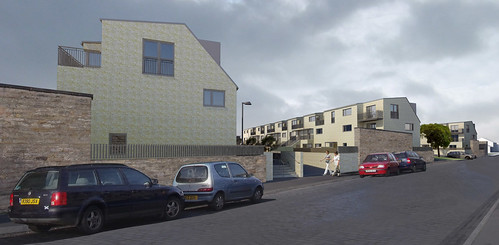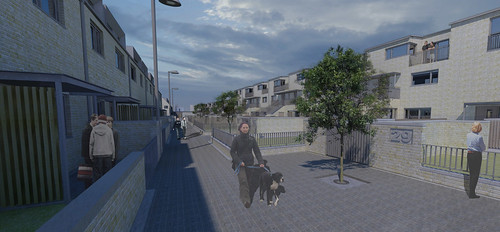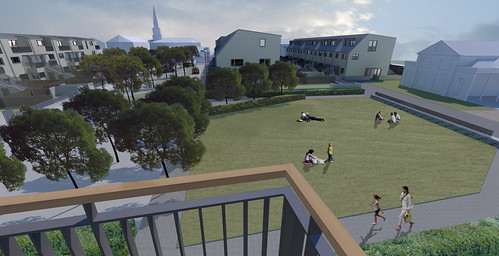http://www.edinburghnews.scotsman.com/news/park-campaigners-in-bid-to-veto-housing-plans-1-3521855
CityCyclingEdinburgh Forum » General Edinburgh
"Park campaigners in bid to veto housing plans" Juniper Green
(22 posts)-
Posted 11 years ago #
-
published by pjmatthews yesterday:
Homo Economicus in a Big Society: Understanding Middle-class Activism and NIMBYism towards New Housing Developments
Abstract
Problems of housing supply and affordability in England have long been recognized by policy-makers. A key barrier to supply is seen to be community activism by so-called not-in-my-back-yard activists (NIMBYs). The localism policy agenda, or devolving decision-making down to the local level, is central to how the UK coalition government seek to overcome this opposition. This conceives NIMBYism as a demonstration of homo economicus – of the rationality of economic beings seeking to maximize their utility. In this view, residents would not accept large urban extensions in suburban areas because they took on localized costs with no obvious benefits, unless incentivised appropriately. In this paper, we use analysis of British Social Attitudes Survey data as well as the results of the first review of middle-class activism in relation to public services to identify the likelihood of residents being incentivized by this version of localism to accept new housing. We conclude that the evidence on the individual and collective attitudes suggests that it is unlikely that localism will deliver new housing. Importantly, the political power of affluent and professional groups means they can ensure that their opposition is heard, particularly in the neighbourhood plans delivered through localism. The paper argues that planning for housing needs to understand communities as homo democraticus – as actively engaged in negotiating between complex interests with respect to support for new housing.http://www.tandfonline.com/doi/full/10.1080/14036096.2014.947173#.U_27W_lT7W9
Posted 11 years ago # -
"
The paper argues that planning for housing needs to understand communities as homo democraticus – as actively engaged in negotiating between complex interests with respect to support for new housing."
Good luck with that!
In some circumstances the 'locals' have good reasons to challenge the imbalances of power - politicians/planners/developers.
(Even if it is only done out of self interest!)
Of course Nimbies 'stand in the way of progress'.
Sometimes it's hard to know what progress is.
David Steel was on the radio this morning saying he was on the last train out of Galashiels ("Beeching cuts") and hopes to be on the first train back.
That'll 'bring' lots more housing!
Posted 11 years ago # -
The most depressing part of the findings, i thought was:
"Overlaying the regional patterns, there is a general tendency for support for new housing to be high in larger and more central city areas, where there is generally less spare land to build, and somewhat more support in both run-down industrial areas and remoter rural areas. From this analysis, we can say that the stereotype of the middle-class NIMBY community activist in the south of England is broadly supported – the areas where opposition to development is strongest are suburban and small town areas in more accessible locations, particularly in the prosperous south of England."
ie a far higher proportion of people in the southeast oppose new home building than in Scotland.
Posted 11 years ago # -
Sometimes it's hard to know what progress is.
Indeed! sooner or later, continuing to build over a limited supply of "green" land ceases to be seen as progress, and making the best use of otherwise vacant and purposeless land becomes progress.
Change does not always equate to progess.
Posted 11 years ago # -
(Even if it is only done out of self interest!)
What other kind is there in these situations. Building a housing estate on park land isn't going to bring any real benefits to the current residents of Juniper Green, the local shops are just as unlikely to benefit as the guy who commutes to the city centre every morning.
They've still not built on the flats behind Broomhouse just a mile or so away, the old fruit market is still a gap site just four miles away. Whilst this may be nimbyism I'd say it is at least justified.
I wonder if building on greenfield around Balerno is better than a park, not sure... Though there is still plenty of brownfields that could be developed.
Posted 11 years ago # -
Will we be happy when we've built over every last piece of land in Britain?
The problem with new developments is they just plant a load of
housescardboard boxes. They never contribute anything back to wider society - new schools, new local shops, new parks, new railway stations, new cycle track.Posted 11 years ago # -
"What other kind is there in these situations."
By "self interest" I was meaning 'keep things the way they were when I moved in"/'protecting my view'/'preserving my house value'/ etc.
"Other kind' could be 'preserving the park for people to use', 'real concerns about overloading local facilities - schools roads etc.' - plus 'wider concerns' about land use, appropriate development etc.
The apparent ease with which green field/'peripheral' developments sometimes get approved means it will take longer to get 'brownfields' developed.
Though of course the 'value' of such sites may be stuck on balance sheets at unrealistic levels.
Posted 11 years ago # -
Though of course the 'value' of such sites may be stuck on balance sheets at unrealistic levels.
Knowing they can force through de-greenbelting (or de-greening in general, see Craighouse campus) of land if they try hard enough and are persistent enough hardly gives developers the incentive to develop the brownfields, whose development values would surely increase if land supply was restricted through stronger prevention of outward urban spread.Do owners of these large plots of vacant land, gathering weeds, pay tax on it? If they do, I doubt it's enough to stop the practice of landbanking and then sitting on it until there's a chance to fill it full of "executive penthouses" at the upward part of a housing bubble and make a buck.
Posted 11 years ago # -
This issue is only going to get worse in the Edinburgh area.
I was at a presentation about the LDP on Monday. Nearly all the new developments planned in the next decade will be on greenfield sites, primarily to the west, south west, south, and south east of Edinburgh.
There are a few brownfield sites in the plan, eg. the Lochend butterfly. The north Edinburgh pre-crisis 'strategic development areas' of Granton, Newhaven harbours etc. are still in there, but there are no immediate plans from developers for either of these areas.
This is the "invisible hand of the market" at work. It seems most families want to live in suburban Barrett boxes (other housing developers are available) with a garden, a garage to put the washing machine in, a driveway to park two cars, preferably in a cul-de-sac amongst near-identical housing. The gridlock on 'arterial routes' into Edinburgh will really be something in a few years.
If folk living in outer Edinburgh don't want their green areas turned into a thousand Brookside Closes or Hollyoaks, better start objecting now. May not do much good, however.
Sigh.
Posted 11 years ago # -
What I find most curious about the current range of proposals are that the objections are mostly coming from people living in houses which were built in greenfields in the middle of the 20th Century. Of course now that they own their own piece of suburbia don't want the next batch of greenfields to be developed.
My primary dislike to these developments is their impermeability to anything other than the sacred motor vehicle. If they could be built using something like East Craigs as a model they would be far more pleasant but that would create a lower overall density and so lower profits.
Posted 11 years ago # -
It seems most families want to live in suburban Barrett boxes
I wonder if that's really true, or is the result of developers 'playing it safe'. If the choice is between a suburban box with a garage and garden, or an urban rabbit-hutch with poky rooms and low ceilings, it's not really much of a choice. I'd like to think that with some architectural flair (perhaps combined with more up-to-date eco-friendly building techniques), developers could create spacious yet higher-density developments that would appeal to the next generation of family-raisers. A fair proportion of those potential buyers may have moved our from the city centre where they may not even have owned a car. Sometimes car use is more or less 'forced' by the developers' assumptions that no other forms of transport need to be catered for.
Maybe I'm just being naively optimistic of course...
Posted 11 years ago # -
...developers could create spacious yet higher-density developments...
These are known as Victorian tenements
Posted 11 years ago # -
These are known as Victorian tenements
Yes, in terms of stacking/floor area/ceiling height (creating a much more spacious feeling but with a smaller 'footprint' than a Barratt Box). But I was thinking in terms of sustainable building materials (i.e. not stone) and perhaps some features that would appeal to 21st century buyers (e.g. roof terraces, basements for storage).
I also think town houses (3+ storeys, with garage/storage/utility on ground level and living space above) are a much better use of land than typical cul-de-sac developments.
Posted 11 years ago # -
I went to a talk by Malcolm Fraser about designing a better built environment for people to live and work and play in. He spent a lot of time giving greenwashed eco-towns a dressing down, and also local and national authorities for their wasteful practice of abandoning good quality old buildings e.g. schools and hospitals and replacing them with cheap[ly built], hugely over-priced modern crap where such things as a nice view, daylight and ventilation are rarely if ever put high up the list of priorities.
Anyway, he was citing an example of trying to reintroduce Colonies-style housing into the Edinburgh property landscape and how he had been pushing it to developers for many years. The difficulty he said was not an unwillingness from the builders to build but an unwillingness from the accountants to be able to work out what they would sell for, how to price and what sort of profit margins would be forthcoming. Why take a risk on reducing your margins with new colony housing when you could go for tried-and-tested cornflake packet & legobrick houses or "apartments" by the hundred.
There has been change on this front though - new colonies are just being finished off in Bellevue, between Macdonald Road and Annandale Street and they look quite appealingly designed and built and modern-brick construction asides, quite fit in with the Edinburgh built landscape. Despite how popular the old colonies are with buyers, it took a social housing association they eventually got on board to put up the money.
Posted 11 years ago # -
"
Further to our recent appointment at West Pilton Crescent, the practice has been appointed by 21st century Homes to masterplan the historic Leith Fort site. Demolition of the existing 1960s tower block is due to commence in the new year, and we have been asked to create a new community of around 100 social housing units within the confines of the original, listed Fort walls.
"
Posted 11 years ago # -
Some designs for the Fort by MF -


 Posted 11 years ago #
Posted 11 years ago # -
Malcolm Fraser seemed very keen on public spaces that are not just window-dressing for a development, but useful public spaces for a community. He told a tale of the local councillor who seemed horrified he had designed in a public area with benches, because people "might gather there". I paraphrase, but the response was along the lines of "well, Du-uh-uh!"
Posted 11 years ago # -
Where's the space for cycling?
Posted 11 years ago # -
"
WORK on the long-awaited multi-million-pound transformation of Craigmillar is set to begin next year.
Blueprints for the delayed £200 million project to revive the town centre were submitted to planning chiefs this week.
The £60m first stage will see the building of more than 300 homes and a shopping centre. The 50-acre site will also have a restaurant, a supermarket and a petrol station.
...
Mark Harris, senior development manager at Parc, said: “These plans will see a hugely revitalised town centre at Craigmillar, providing residents a bolstered retail offering, and civic and green space for local residents and families to enjoy.
"
http://www.edinburghnews.scotsman.com/news/200m-craigmillar-project-to-start-next-year-1-3523186
Posted 11 years ago # -
Posted 11 years ago #
-
Excellent design. Get rid of all those inconvenient trees and you could double the parking space.
Posted 11 years ago #
Reply
You must log in to post.


 posts
posts
